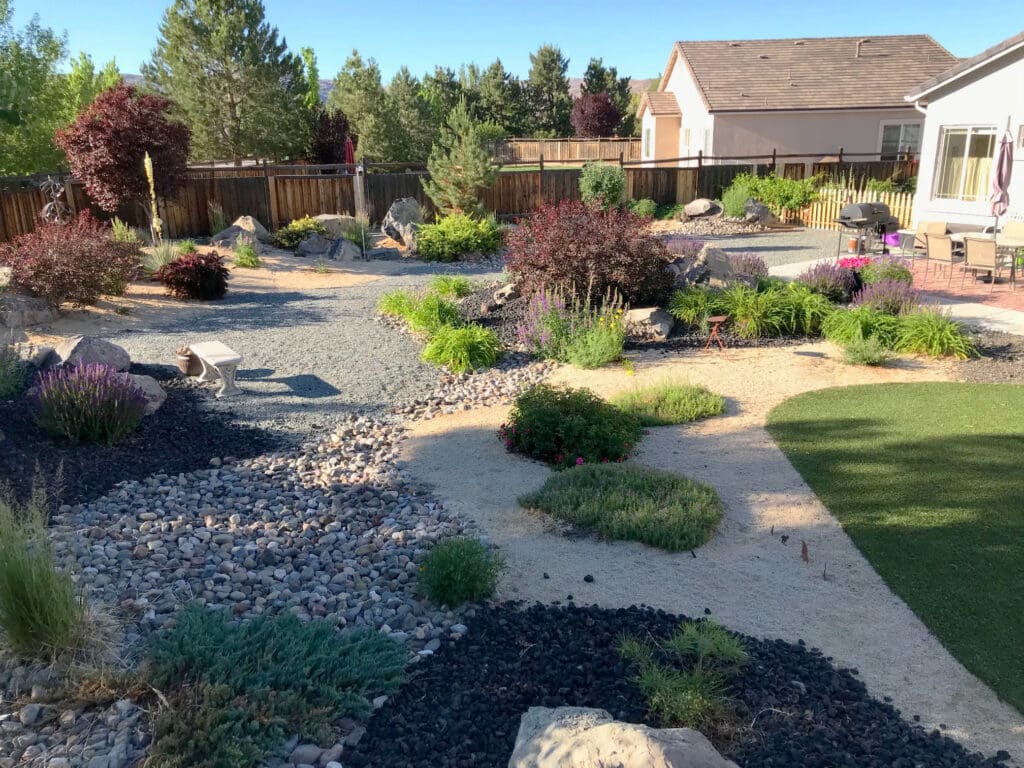As I walk through the Reno and Sparks area, I can see how our high-desert climate challenges lawns and gardens. Many homeowners struggle to maintain lush landscapes while managing rising water bills. That’s where drought-tolerant plants make all the difference. By incorporating these resilient species, we can create landscapes that are both stunning and sustainable—gardens that flourish with less water and care. One of my favorite combinations includes Agave parryi, a cold-hardy succulent that serves as a beautiful focal point, and Lantana camara, known for its vibrant blooms that attract butterflies and hummingbirds. These choices not only conserve water but also add rich color and texture to your yard.
Drought-tolerant doesn’t mean dull. When planned thoughtfully, these gardens can be lush and full of life. For example, pairing Myoporum parvifolium (Creeping Myoporum) with Salvia dorrii (Desert Sage) creates a striking balance of soft greens and bright purple blooms. Myoporum’s dense groundcover complements the vertical interest of Desert Sage, producing a beautiful, layered look. Both plants are well-suited to Reno’s USDA zones 6b–7b and require minimal watering once established—perfect for busy homeowners who still want vibrant outdoor spaces.

At Little City Landscaping, we know that drought-tolerant landscapes can be lush, colorful, and inviting without heavy watering. The key lies in creating harmonious combinations of plants that complement one another in texture, color, and water needs. For example, pairing Indian Ricegrass (Achnatherum hymenoides) with Mahonia repens (Creeping Oregon Grape) creates a balanced and dynamic visual. The soft, feathery texture of Indian Ricegrass contrasts beautifully with the bold, evergreen foliage and yellow blooms of Mahonia.
Grouping plants with similar irrigation needs is also essential. Combining Tipuana tipu (Tipu Tree) with Dodonaea viscosa (Hopseed Bush) ensures both thrive with consistent, moderate watering schedules. This approach reduces maintenance and minimizes the risk of over- or under-watering. By thoughtfully grouping plants, you save water and create a cohesive, stress-free landscape.
For added color and seasonal variety, I love pairing Callistemon ‘Little John’ (Dwarf Bottlebrush) with Phlox subulata (Creeping Phlox). The Bottlebrush adds bright red blooms and structure, while Phlox provides a soft, colorful carpet of spring flowers. Both species attract pollinators and perform well in zones 6b–7b, thriving in Reno’s variable temperatures and dry conditions.
Texture and color play vital roles in designing drought-tolerant gardens. Proper spacing and contrast between fine and bold foliage help establish visual balance and year-round appeal. For example, combining Salvia dorrii (Purple Desert Sage) with Acer glabrum (Rocky Mountain Maple) brings structure and softness together. Sage delivers seasonal purple blooms and a delicate fragrance, while the Maple anchors the garden with rich green leaves that turn vibrant red in fall.
Color selection is equally important. Choosing hardy flowering plants such as Lantana, Gaillardia (Blanket Flower), or Echinacea purpurea (Purple Coneflower) ensures bold, long-lasting color even during dry periods. Pairing them with sculptural succulents like Aloe aristata or Sedum spectabile (Showy Stonecrop) creates a dynamic, low-maintenance look. These combinations thrive across USDA zones 6b–7b, offering both resilience and beauty.
Not every plant can withstand Reno’s hot summers and cold winters, which is why local expertise is crucial. At Little City Landscaping, we help clients choose species that naturally thrive in Northern Nevada’s unique conditions. Plants such as Artemisia tridentata (Big Sagebrush), Mahonia repens, Indian Ricegrass, and Creeping Oregon Grape are ideal—they’re hardy, low-maintenance, and adapted to our region’s soil and temperature fluctuations.
Other great choices include Prunus andersonii (Desert Peach), Ericameria nauseosa (Rubber Rabbitbrush), and Penstemon strictus (Rocky Mountain Beardtongue), which provide seasonal blooms, attract pollinators, and add visual interest throughout the year. By selecting plants suited to USDA zones 6b–7b, you’ll enjoy a landscape that remains vibrant through all seasons while minimizing water use and maintenance.
Creating a drought-tolerant landscape in Reno and Sparks is about blending beauty with sustainability. With the right plant combinations and thoughtful design, you can reduce water use without sacrificing color, texture, or charm. Whether you want to reimagine your yard or add a few resilient species, our team at Little City Landscaping is here to help bring your vision to life.
Contact Little City Landscaping and together we can transform your yard into a stunning, water-wise oasis that thrives in our Northern Nevada climate—proof that conservation and beauty can absolutely go hand in hand.